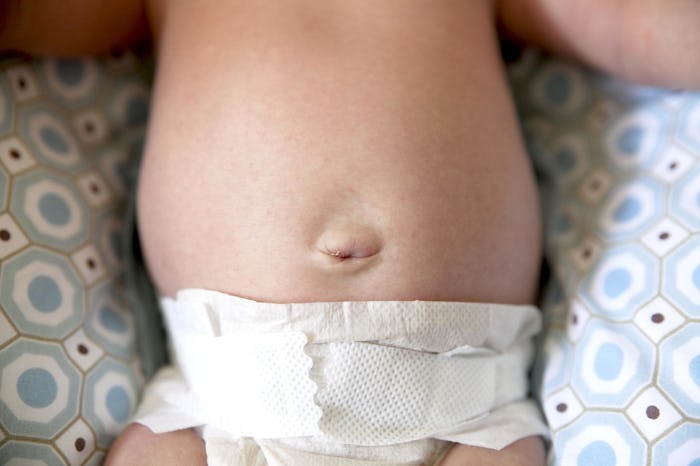When I was pregnant with my first, I gave very clear instructions to my husband, who was planning to cut the cord, not to give our daughter an "outie" belly button. Now, I realize this was a very silly thing to care about, but my anxiety about impending labor had to be directed somewhere, and for me, that was the belly button. I found myself wondering, does a baby's belly button change? Can you go from an outie to an innie? What are the logistics?
I'm about to blow your mind here, but how a belly button ends up looking — innie or outie — has nothing to do with the cord cutting. I know, mic drop. "As babies are growing inside the womb, skin grows around the umbilical cord,” said Michael Schoenwetter, M.D., a pediatrician in private practice near Los Angeles, in an interview with NewParent. “Some babies grow more skin, which results in an outie, and some grow less, making an innie.”
However, a look at the numbers reveals that innie belly buttons vastly outnumber outies. "Only 4 percent of those studied said they had outie-shaped belly buttons," according to Everyday Health reporting on the Belly Button Diversity Project, which has collected nearly 500 samples from belly buttons.
The irony about me worrying about belly buttons so much when I was pregnant with my first, and not at all when I was pregnant with my second, was that my second daughter was indeed born with a very significant outie! In fact, she was diagnosed as having an umbilical hernia, which is when the belly button bulges out. "An umbilical hernia occurs when part of the intestine protrudes through the umbilical opening in the abdominal muscles. Umbilical hernias are common and typically harmless," explained Mayo Clinic. "In children, many umbilical hernias close on their own by age 1 or 2, though some take longer to heal."
My daughter is now 18-months-old and her belly button still protrudes ever so slightly but the hernia is gone. I also find her belly button irresistibly cute, and can't help giving her belly raspberry kisses every chance I get.
But aside from an umbilical hernia-related "outie" belly button eventually becoming an innie, you're basically stuck with the belly button you're born with (unless you decide to get a plastic surgery procedure called an umbilicoplasty). There's only one other instance when a belly button is known to transform and that is with pregnancy.
When you're pregnant, you body swells in all of kinds of places, and your belly button is not immune to these changes. "Your expanding uterus puts pressure on the rest of your abdomen, pushing your belly button outward," explained Parents. However, after you give birth and your uterus shrinks back down, your belly button is likely to return to normal.
You may also experience another belly button phenomenon when your pregnant belly expands — your innie stretches really taut. "Sometimes a belly button will pop out. Sometimes it sort of caves inwards and lays flat," explained VeryWell Family. Either way, it's completely normal!
